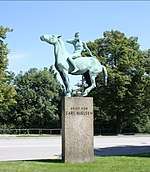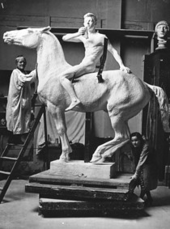Carl Nielsen Monument
The Carl Nielsen Monument, located at the corner of Grønningen and Store Kongensgade in central Copenhagen, Denmark, is a monument to Danish composer Carl Nielsen created by his wife Anne Marie Carl-Nielsen. It depicts a young man playing pan-pipes on a wingless Pegasus and is also known as The Genius of Music (Danish: Musikkens Genius). The original plaster model is owned by the Carl Nielsen Museum in Odense.
| Location | Copenhagen, Denmark |
|---|---|
| Designer | Anne Marie Carl-Nielsen |
| Type | Equestrian statue |
| Material | Bonze and granite |
| Opening date | 17 December 1939 |
| Dedicated to | Carl Nielsen |
Description

The monument is an allegorical equestrian statue. Horse and man are depicted in a dynamic pose. The naked young man with pan-pipes represents Pan, god of music in Greek mythology. His face strongly resembles that of a young Carl Nielsen.[1] The Pegasus figure had wings in Anne Marie Carl-Nielsen's earlier models but the wings were left out in the final design.
Carl-Nielsen has commented on the design that "What I wanted to show in my figure is the forward movement, the sense of life, the fact that nothing stands still."[2]
History

Carl Nielsen died on 3 October 1931. The monument was a donation from the Committee for the Creation of a Monument to the Composer Carl Nielsen and the Foundation for the Advancement of Artistic Purposes (Fonden til kunstneriske Formaals Fremme).[3]
Anne Marie Carl-Nielsen was commissioned to design the monument. She worked on it in her studio in Civiletatens Materialgård at Frederiksholms Kanal 26. She wrote: "I wanted to take the winged horse, eternal symbol of poetry, and place a musician on its back. He was to sit there between the rushing wings blowing a reed pipe out over Copenhagen". Dispute about her design and a shortfall in funding meant that the monument was delayed and that Anne Marie herself ended up subsidising it. It was finally unveiled on 17 December 1939.[4]
References
- "Fokus på billedhuggeren Anne Marie Carl-Nielsens produktion". Odense Museum (in Danish). Retrieved 27 April 2018.
- Lawson 1997, pp. 216–217.
- "Monument for komponisten Carl Nielsen". sites.itera.dk (in Danish). Retrieved 27 April 2018.
- Holmen 1985, pp. 29–31.
Citations
- Holmen, Grethe (1985). "Anne Marie Carl-Nielsen and Anne Marie Telmànyi: Mother and Daughter". Woman's Art Journal. 5 (2): 28–33. doi:10.2307/1357963. JSTOR 1357963.CS1 maint: ref=harv (link)
- Lawson, Jack (1997). Carl Nielsen. London: Phaidon Press. ISBN 0-7148-3507-2.CS1 maint: ref=harv (link)
External links
| Wikimedia Commons has media related to Carl Nielsen memorial (Nyboder, Copenhagen). |
- Image of earlier design
- Kildemoes, Nana (2018). "Anne Marie Carl-Nielsen, Musikkens Genius – et hjertebarn". museum odense. Odense. Retrieved 28 April 2018.
- Source